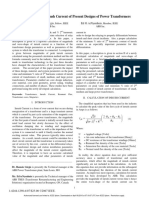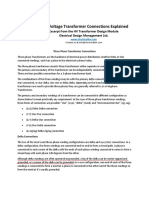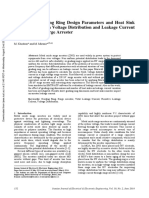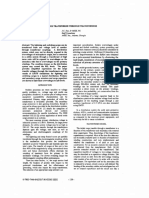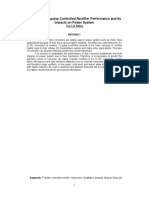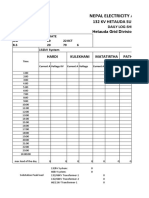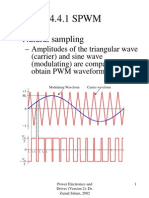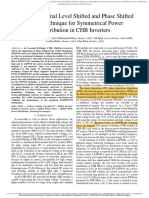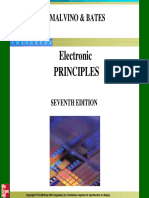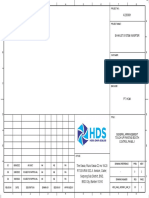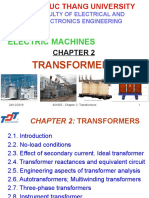At a glance
Powered by AI
The document discusses the use of phase shifting transformers and multi-pulse rectifiers to reduce current harmonics in power systems.
International Conference on Emerging Trends in Engineering ©ICETE 2011
Current Harmonic Analysis of Multi Pulse Diode Rectifiers with Phase Shifting Transformers
J. Venkat Nag Someswar Rao, Mahendra Ghat, S. Kumaravel
Dept. of Electrical Engg.NIT Calicut, Dept. of Electrical Egg. NIT Warangal, Dept. of Electrical Engg.NIT Calicut
jvenkat.eng@gmail.com,mahendra.ghat@gmail.com,
kumaravel_s@nitc.ac.in
Abstract:
The objective of this paper is to analyze the current harmonics in source for different configurations of multi pulse diode rectifiers. Multi pulse rectifier is generally composed of a phase-shifting transformer with multiple secondary windings; feed
’s
a set of identical six-pulse rectifiers. The rectifiers can be configured as 12, 18 or 24-pulses. In this paper Total Harmonic Distortion (THD) of currents in source for different rectifier configurations are discussed with their MATLAB simulations.
Keywords
-Phase shifting Transformers, Phase angle, Multi Pulse Diode Rectifiers. I. INTRODUCTION
In order to mitigate harmonic requirements set by IEEE Standard 519-1992, major high-power drive manufacturers around the world are drastically using multi pulse diode rectifiers in their drives as front-end converters. The rectifiers are powered by a phase shifting transformer with a number of secondary windings. Each secondary winding feeds a six-pulse diode rectifier. The dc output of the six- pulse rectifiers is connected to a voltage source inverter.
A. Phase Shifting Transformer:
Phase Shifting Transformer (PST) is essential device in Multi pulse diode rectifiers, which provides electrical isolation to rectifier from utility supply and phase displacement between primary and secondary Voltage for harmonic cancellation. According to winding arrangement transformers can be classified as Y/Z and /Z(Y-star, -delta and Z-zigzag). Both configurations can be equally used in multi pulse rectifiers. Fig. 1(a) & 1(b) shows the connection diagrams of Y/Z and /Z configuration. The primary is wounded with winding N1 turns per phase and secondary is wounded with two windings, N2 and N3 turns per phase. In this paper Y/Z configuration is described as shown in Fig.1 (a).According to Y/Z configuration secondary voltages will lead primary voltages as shown in phasor diagram Fig.1(c), represented by subscript-1 (Y/Z-1). While reversing the connections of secondary winding N2 as shown in Fig.1 (d), secondary voltage will lag the primary voltage as shown in phasor diagram Fig.1 (e), represented by subscript-2(Y/Z-2). Table1 shows the turns ratio for various phase angle () between primary & secondary and with application.
Fig. 1(a) Y/Z connection diagram for lead
International Conference on Emerging Trends in Engineering ©ICETE 2011
Fig. 1(b)
/Z connection diagram for lead
Fig. 1(c)
Phasor diagram of Y/Z connection diagram for lead Fig. 1(d) Y/Z connection diagram for lag Fig. 1(e) Phasor diagram of Y/Z connection diagram for lag Table 1
B. Multi Pulse Diode Rectifiers:
Multi pulse diode rectifier is advantageous in reducing line current harmonic distortion using a phase shifting transformer, by which some lower order harmonic currents generated by six-pulse rectifiers are neutralized. In general, higher number of rectifier pulses lowers the line current harmonics. Rectifiers with more than 30 pulses are rarely used due to increase in transformer cost and limited performance. Multi pulse rectifiers have more features like; it
won’t
require LC filters or power factor compensators by which LC resonances can be eliminated. It is used to block common mode voltages generated by the rectifier and inverter in medium voltage drive, which would otherwise appear at motor terminals, due to which winding insulation failure. The multi pulse diode rectifiers are classified in two types: a)
Series-type multi pulse rectifiers:
All six-pulse rectifiers DC output is connected in series. In medium-voltage drives, series-type rectifier can be used as a front end rectifier for inverter, which requires a single DC supply, such as three-level neutral point clamped inverter and multilevel flying-capacitor inverter. b)
Separate-type multi pulse rectifiers:
Each
six- pulse rectifier feds a separate DC load. This type of - Application Y/Z-1 Y/Z-2 0 0 1.0 1.0 12-, 18-, and 24-pulse rectifiers 15 -15 0.366 0.707 24-pulse rectifiers 20 -20 0.227 0.653 18-pulse rectifiers 30 -30 0 0.557 12- and 24- pulse rectifiers
International Conference on Emerging Trends in Engineering ©ICETE 2011
rectifier is suitable for multilevel cascaded H-bridge inverter, which requires a multiple units of isolated DC Supply.
II. HARMONIC ELIMINATION (CURRENT)
As shown in Fig. 2 for a 12-pulse rectifier, Phase angle () between primary and secondary for Y and connections are 0° and 30° respectively. The voltage ratio is = = 2. Fig. 2. 12-pulse diode rectifier Secondary line current can be expressed as
……… (1.a)
……… (1.b)
Where n = 1, 5,7,11 Where
i
A
is primary current, while seeing the secondary currents from primary the phase angle of all harmonic components will be same because of Y/Y connection. Secondary current on primary is
….
(2) On transforming
….. (3.a)
)
…
(3.b) The primary line current
……4
Where 5th, 7th, 17th, and 19th harmonic currents in and are 180° out of phase, therefore canceled. It is proved that for multi pulse rectifiers with phase shifting transformers whose consecutive in-phase secondary voltages are differ with a phase angle , only (mn1)
th
harmonics present on primary side. Where m = 6 for 6-pulse, 12 for 12-pulse, 18 for 18-pulse and so on, and n= 1, 2, 3
……..
III SIMULATION ANALYSIS
In this section MATLAB simulation for six pulse rectifiers and 12 Pulse rectifiers with Phase shifting transformer are shown.
Fig. 3 MATLAB model for 12 pulse diode rectifier
Simulink model for 12 pulse diode rectifier is shown in Fig. 3.
For simulation following parameters are taken as input: Supply Voltage: Resistive Load: R=450 watt at nominal Voltage 1000V
International Conference on Emerging Trends in Engineering ©ICETE 2011
Waveform of line current drawn by six-pulse diode rectifier is shown in Fig. 4. Line current waveform contains two separate pulses per half-cycle of supply frequency, which makes the DC current discontinuous. Harmonic spectrum of line current is shown in Fig. 4. Line current does not contain any even-order harmonics since; current waveform is half-wave symmetry
.
The dominant harmonics, such as 5
th
and 7
th
order have a higher magnitude than others. Line current THD is a function of fundamental current, THD = 23.50%, 5th and 7
th
harmonic component related to fundamental are 21.54% and 7.82 % respectively [table-2]. Fig.4 Line Current wave forms for six pulse Diode Rectifiers Fig.5 Line Harmonic contents of six pulse Diode rectifier Table 2 Harmonics related to fundamental frequency for 6- pulse rectifier 50 Hz(fundamental) 100% 250Hz (5
t
harmonic) 21.54% 350Hz (7
t
harmonic) 7.82% 550Hz (11
t
harmonic) 5.52% 650Hz (13
th
harmonic) 2.73% 850Hz (17
t
harmonic) 1.79% 950Hz (19
t
harmonic) 0.93% Fig.6 Current Waveforms of 12 pulse Diode rectifier Fig.7 Line Harmonic contents of 12-pulse Diode rectifier Fig.2 shows a typical configuration of 12-pulse series type rectifier. Fig. 6 shows various simulated current waveforms of the rectifier operating under rated



















